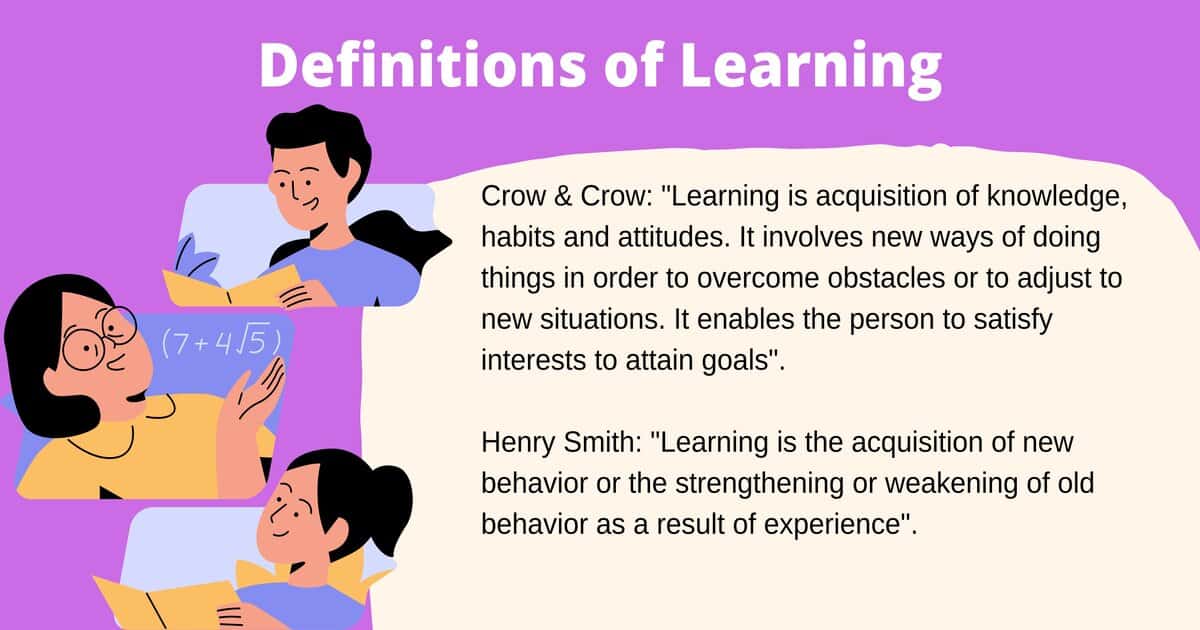Definitions of Learning
by Yuvi - November 14, 2020
Education and learner diversity in classroom and learning definition
Definitions of Learning.
Meaning of learning by Crow & Crow: “Learning is acquisition of knowledge, habits and attitudes. It involves new ways of doing things in order to overcome obstacles or to adjust to new situations. It enables the person to satisfy interests to attain goals”.
Meaning of learning by Henry Smith: “Learning is the acquisition of new behavior or the strengthening or weakening of old behavior as a result of experience“.
Wood worth defines learning as –
“Any activity can be called learning as far as it develops the individual (in any aspect, good or bad).
& makes his behavior & experiences different from what would otherwise have been”.
Thus
Learning may be defined as any relatively permanent change in behavior.
Learning may be defined as the acquisition of knowledge attitudes, skills & ways of thinking.
Learning is the permanent change in behavior for better or worse which results / occurs as a result of practice & experience.
Above learning definitions have 3 important elements:
- Learning is a change in behavior for better or worse.
- It is a change that takes place through practice & experience.
- Before it can be called learning, the change must be relatively permanent i.e. it must last for a long time. Exactly how long cannot he specified, but we usually think of learning lasting for days, months, years in contrast to temporary, behavioral effects.
Thus learning is a complex process. It is a process by which all organisms, as a result of its interaction in a situation acquires a new mode of behavior which tends to persist and affect his behavior in the future.
Thus learning takes place when an organism reacts to a situation. It consists of certain changes in behavior or adjustments and this type of behavior is utilized to some degree in other situations.
Definition of Learning Styles
You have probably noticed that when you try to learn something new you prefer to learn by listening to someone talk to you about the information. Or perhaps you prefer to read about a concept to learn it, or maybe see a demonstration.
1) Learning styles can be defined, classified, and identified in many different way.
2) Generally, they are overall patterns that provide direction to learning and teaching.
3) Learning style can also be described as a set of factors, behaviors, and attitudes that facilitate learning for an individual in a given situation.
4) Styles influence how students learn, how teachers teach, and how the two interact.
5) Each person is born with certain tendencies toward particular styles, but these biological or inherited characteristics are influenced by culture, personal experiences, maturity level, and development.
6) Style can be considered a “contextual” variable or construct because what the learner brings to the learning experience is as much a part of the context as are the important features of the experience itself.
7) Each learner has distinct and consistent preferred ways of perception, organization and retention.
8) These learning styles are characteristic cognitive, affective, and physiological behaviors that serve as pretty good indicators of how learners perceive, interact with, and respond to the learning environment.
9) Students learn differently from each other and it has been determined that brain structure influences language structure acquisition.
10) It has also been shown that different hemispheres of the brain contain different perception avenues.
11) Some researchers claim that several types of cells present in some brains are not present in others.











